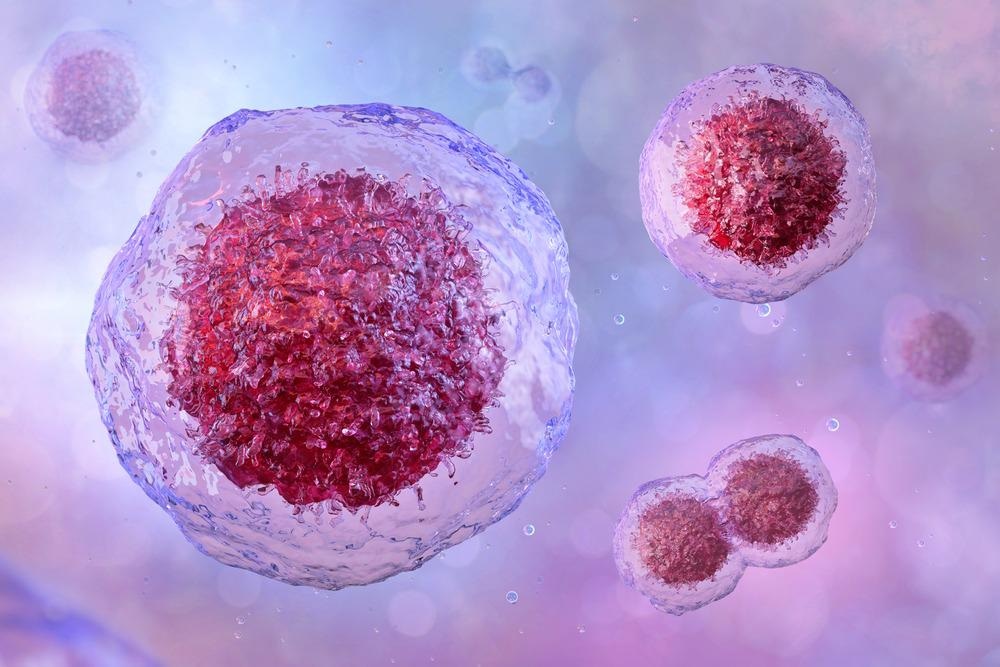An article published recently in the journal ACS Nano highlights the effectiveness of combinatorial nanoarrays in systematically evaluating the role of biophysical cues within direct cell reprogramming.

Study: Predictive Biophysical Cue Mapping for Direct Cell Reprogramming Using Combinatorial Nanoarrays. Image Credit: Corona Borealis Studio/Shutterstock.com
Cell Programming
Direct cell reprogramming possesses significant potential for regenerative medicine and cell-based tissue engineering. In order to fully realize its therapeutic potential, precise regulation of cell fate and a complete understanding of cellular responses corresponding to the surrounding microenvironments are required.
Typically, direct cell reprogramming is regulated by the epigenetic landscape alterations and dynamic interactions between several microenvironmental signals. However, the function of cell microenvironments in the epigenetic regulation of gene pathways to control cell reprogramming or fate is notably complicated, which increases the difficulty of engineering, tracking, and predicting the function.
In cell microenvironments, cell-cell interactions, biophysical/insoluble cues, and soluble cues are the three major types of signals. Among them, biophysical/insoluble cues, such as elasticity, topography, and geometry of the extracellular matrix (ECM) were identified as crucial regulators that determine the cell behaviors such as reprogramming, migration, differentiation, and adhesion.
The quantitative, trackable, and predictive investigation of the biophysical cue function in specific cell reprogramming processes was not well-established until now owing to the intrinsically high complexity and heterogeneity of the biophysical signaling pathways. Existing assays for systematically evaluating the cellular responses to several biophysical cues, specifically those cues with complex ECM structures, still require further improvements.
Thus, a reliable method is necessary to thoroughly investigate the biophysical cues and identify the optimum biomaterial conditions for different biomedical applications.
The Study
In this study, researchers created dynamic interference lithography (DIL)-based method to produce combinatorial biophysical cue (CBC) arrays to predict cell reprogramming mediated by biophysical cues. Later, they combined the generated CBC array with the high content cell screening to demonstrate the mapping of cell behaviors directed by biophysical cues.
A DIL with a curved interferometer was utilized to fabricate the CBC nanoarrays. Differentially structured CBC nanoarrays were generated by modulating the unsymmetrical Lloyd’s mirror interferometer parameters through optical simulations. Line-shaped CBC nanoarrays and dot-shaped CBC nanoarrays were generated through single exposure and two exposure events, respectively.
Homogeneous PR patterns with single topographies were created by integrating regular Lloyd’s mirror with the interferometer. The fabricated CBC nanoarrays were characterized at different scales by performing, optical microscopy, atomic force microscopy (AFM), helium-ion microscopy (HIM), and field-emission scanning electron microscopy (FESEM).
The human dermal fibroblast cell line was used for cell culture. Immunocytochemistry was conducted to evaluate the topography-regulated cell behaviors after the fixation of CBC nanoarrays. A Nikon T2500 inverted fluorescence microscope was employed to obtain fluorescence images. Hierarchical structures were fabricated using photomask-laser interference lithography (LIL) with hierarchical lithography.
Observations
CBC nanoarrays comprising one-dimensional (1D) nanostructures spanning an extensive range of nanoscale and microscale topographies with sizes spanning from sub-hundred nanometers to tens of microns that are suitable for biophysical cue screening and mapping were successfully fabricated, which validated the reliability of the DIL method.
A single library covering thousands of grid- and fibrous-shaped ECM structures at the multiscale, microscale, and nanoscale were created by the two-step DIL method with a single rotation between the steps. Additionally, libraries with 120O angles were also fabricated as a proof-of-concept using the same method and rotation angles.
The nanoscale topographies were indexed on the substrate depending on their locations to conveniently track the ECM-cell interactions. These topographies were tracked by exponential functions for systematic, precise, and detailed investigation of biophysical cues. Moreover, a high-throughput CBC array generation was achieved through the DIL technique. The use of the mask-free DIL technique led to the formation of thousands of ECM topographies within a few minutes.
The mapping facilitated the prediction of ideal nanotopographies among the several sophisticated ECM structures, including different combinations of nano/micro hierarchical topographies, for direct cell reprogramming. The CBC array-based cell screening represented a less biased and highly comprehensive process.
The microscale features in the hierarchical structures were controlled by vertically-aligned microscale masks, while the nanoscale features were defined by the interference patterns. The mature neuronal marker (MAP2) positive cells that were differentiated from fibroblasts demonstrated a distinct neuron-like morphology, and they were derived in several days without requiring any complex growth factor cocktails or viral vectors, which is suitable for timely disease treatments.
The interferometric nature of the nanofabrication method for generating CBC nanoarrays allowed the incorporation of several topographies and light-sensitive materials such as hydrogels for future biological screening applications.
Taken together, the findings of this study demonstrated that CBC array-based assessment approaches and mapping platforms possess an exceptional potential for investigating and predicting biophysical cues at higher complexities within direct cell reprogramming. However, further understanding of the scale of forces that are responsible for fibroblast reprogramming on the CBC nanoarray is required to monitor these forces in several cell-topography interactions on a large substrate.
Reference
Pongkulapa, T., Yang, L., Rathnam, C. et al.(2022) Predictive Biophysical Cue Mapping for Direct Cell Reprogramming Using Combinatorial Nanoarrays. ACS Nano. https://pubs.acs.org/doi/10.1021/acsnano.1c10344.
Disclaimer: The views expressed here are those of the author expressed in their private capacity and do not necessarily represent the views of AZoM.com Limited T/A AZoNetwork the owner and operator of this website. This disclaimer forms part of the Terms and conditions of use of this website.